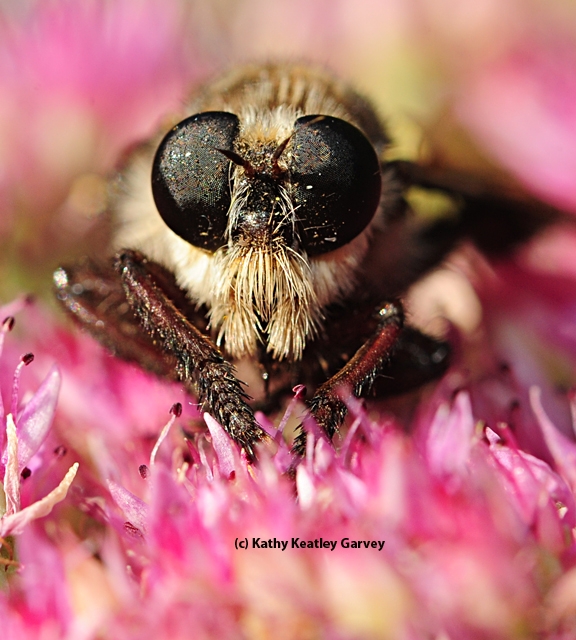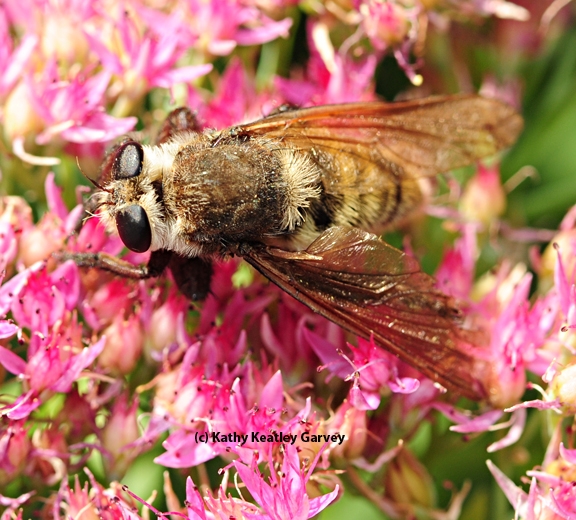- Author: Kathy Keatley Garvey
If it's Friday, it must be Friday Fly Day.
The calendar crawls slowly sometime, but its numbers do not lie.
It's Friday Fly Day, all right, which means it's a good day to post an image of a fly, this time a robber fly.
As kids, we used to play epic battles of "cops and robbers," but neither cops nor robbers visited our family farm in Washington state.
Never saw any robber flies, either.
Several years ago, however, we noticed a robber fly in our family's pollinator garden in Vacaville.
With its bristly moustache, huge eyes and solid stare, it looked absolutely menacing. This is Mallophora sp., as identified by robber (assassin) fly expert Charlotte H. E. Alberts, a UC Davis doctoral candidate who studies these insects.
Scientists tell is that it's an aggressive predator known for its speed, strength, and power. The robber fly lies in wait and ambushes flying insects, including honey bees, syrphid flies, grasshoppers, dragonflies, damsel flies and others--many larger than it is. It stabs its prey with its short, powerful proboscis, injects a paralyzing toxin that liquifies the insides, and then sucks out the content.
Probably not something you want to think about too much, right? (Check YouTube)
These insects, found throughout much of the world (there are more than 7000 species in the robber family Asilidae), can be as long as two inches and as short as 0.2 inches.
If you look on BugGuide.Net, you can see robber flies attacking other insects, including syrphids or flower flies.
It was the robber fly's bristly moustache, though, that fascinated us. Actually it's called a mystax, derived from the Greek mystakos, which mean "moustache" or "upper lip." Perhaps the mystax provides the robber fly with some head and face protection from stinging honey bees in their own version of "cops and robbers."
Happy Friday Fly Day!
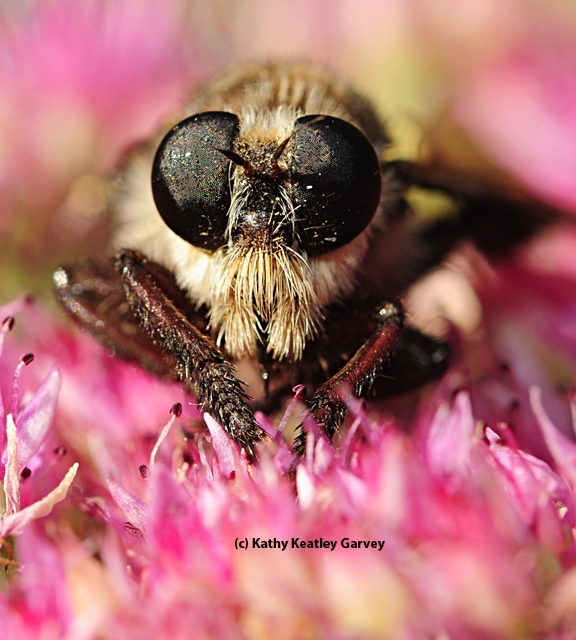
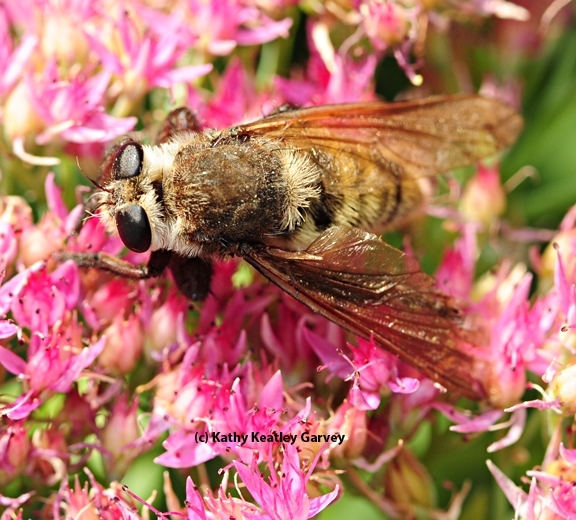
- Author: Kathy Keatley Garvey
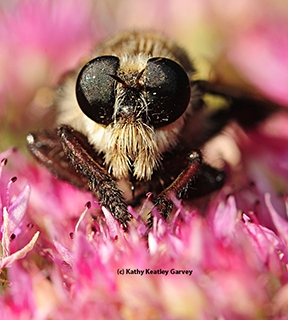
Take it from UC Davis entomology student Wade Spencer.
Spencer decided to create a Bohart Museum of Entomology Christmas card--an insect version--and sure enough, Santa is a robber fly. And Rudolph the Red-Nosed Reindeer is a male argid sawfly.
The idea surfaced when Christine Melvin (who just received her bachelor's degree in entomology from UC Davis) and Spencer were TA'ing (serving as teaching assistants) for Lynn Kimsey's Entomology 100L lab. Kimsey directs the Bohart Museum, home of nearly eight million specimens, and she's a professor in the UC Davis Department of Entomology and Nematology.
The young entomologists decided that the male argid sawfly needed a red nose, just like Rudolph.
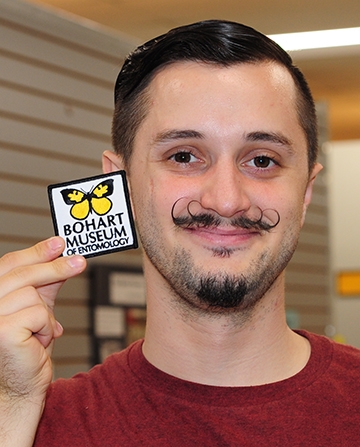
As Spencer was photographing the argids, Bohart Museum teen volunteer Noah Crockette walked by. "He suggested we should find an insect with fluffy white facial setae for an 'insect Santa' and the moment he said that the image of an Asilid (robber fly) popped into my mind."
Spencer then searched through the Bohart's asilid collection and found a perfect robber fly. The rest, as they say, is history--or hysterical.
What's next?
"I'm hoping to image some Phasmids (stick insects) to make an insect menorah for Hanukkah as well," Spencer said. (And he just did! See below)
Remember Wade Spencer? He's the one created a peacock jumping spider costume for the Bohart Museum's inhouse Halloween party. Bohart Museum associate Fran Keller videotaped his courtship dance and it went viral--more than two million hits. See Bug Squad.



- Author: Kathy Keatley Garvey
Check out that moustache!
Once you see the powerfully built robber fly of the Asilidae family, with its huge eyes, short proboscis and bristly "moustache," you won't forget it. It's an aggressive predator known for its speed, its strength, and its power.
The robber fly lies in wait and ambushes flying insects, including honey bees, syrphid flies, grasshoppers, dragonflies, damsel flies and others--many larger than it is. Scientists say the robber fly stabs its prey with its short, powerful proboscis, injects a paralyzing toxin that liquifies the insides, and then sucks out the content.
Sort of like aficionados of Slurpees at the local Seven-Eleven.
Robber flies are the kinds of things you might expect in a science fiction movies--except this isn't science fiction. They've earned their nicknames of "bee killers" and "assassin flies."
These insects, found throughout much of the world (there are some 7000 species in the robber family Asilidae), can be as long as two inches and as short as 0.2 inches.
If you look on BugGuide.Net, you can see robber flies attacking other insects, including syrphids or flower flies.
But check out that bristly moustache! Actually it's called a mystax, derived from the Greek mystakos, which mean "moustache" or "upper lip." Some entomologists think the mystax provides some head and face protection for the robber fly when honey bees and other would-be prey fight back.
